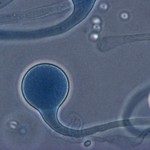Link to Pubmed [PMID] – 26246484
Link to DOI – 10.1128/JCM.01544-15
J Clin Microbiol 2015 Oct; 53(10): 3280-5
Appropriate diagnosis and treatment of eumycetoma may vary significantly depending on the causative agent. To date, the most common fungus causing mycetoma worldwide is Madurella mycetomatis. This species fails to express any recognizable morphological characteristics, and reliable identification can therefore only be achieved with the application of molecular techniques. Recombinase polymerase amplification (RPA) and loop-mediated isothermal amplification (LAMP) are proposed as alternatives to phenotypic methods. Species-specific primers were developed to target the ribosomal DNA (rDNA) internal transcribed spacer (ITS) region of M. mycetomatis. Both isothermal amplification techniques showed high specificity and sufficient sensitivity to amplify fungal DNA and proved to be appropriate for detection of M. mycetomatis. Diagnostic performance of the techniques was assessed in comparison to conventional PCR using biopsy specimens from eumycetoma patients. RPA is reliable and easy to operate and has the potential to be implemented in areas where mycetoma is endemic. The techniques may be expanded to detect fungal DNA from environmental samples.

